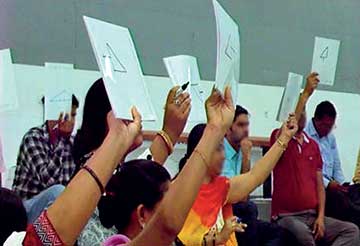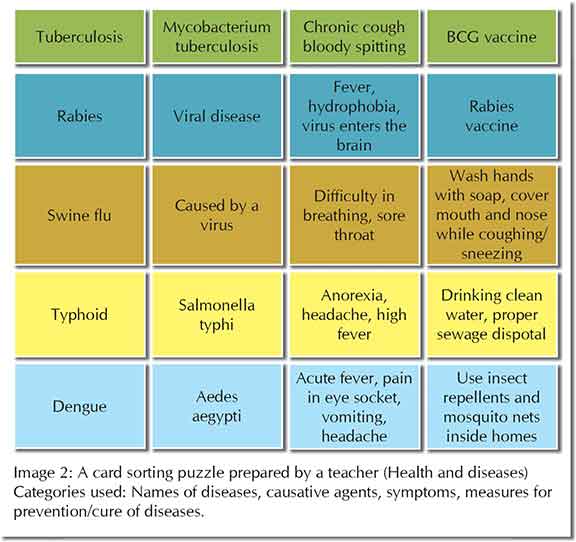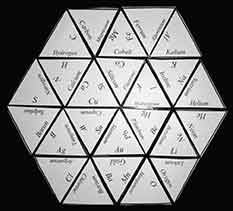Hanza George, Rasika Bhujbalrao, Savita Ladage and Sugra Chunawala
It is a widely accepted fact that teaching-learning in the classroom must be centered around learners and active participation by them. In the Indian context, the National Curriculum framework (NCF) 2005 clearly states that ‘….. In the constructivist perspective, learning is a process of the construction of knowledge. Learners actively construct their own knowledge by connecting new ideas to existing ideas on the basis of materials/activities presented to them…..’ However active learning is not yet a norm in Indian schools. Greater sustained efforts are needed by schools, their managements, teachers, curriculum planners/developers and policy makers so that active learning becomes deeply integrated with school classroom learning. In our opinion, Teacher Professional Development (TPD) programmes present opportunities for in-service teachers to engage themselves with teaching-learning methods/strategies and appropriate activities/instructional materials that can be used for active engagement of the learner.
This article attempts to acquaint the readers, especially chemistry teachers teaching at secondary school level, with some Active Learning Strategies (ALS) that can be adapted in existing classrooms. In the Indian context, ALS are a part of teacher development workshops, organized as part of the ‘RSC-Yusuf Hamied Inspirational Chemistry Programme’. This programme was initiated by the Royal Society of Chemistry (RSC, UK) in 2014 with a generous grant from Dr. Yusuf Hamied. This programme aimed at training chemistry teachers of secondary schools in India and followed a cascade model wherein about 23,000 teachers were trained across the country till December 2018.
The authors of this article were involved with the evaluation of this project specifically for government/government-aided schools in Gujarat, Karnataka, Kerala and Maharashtra. As part of the evaluation, we witnessed the use of ALS in the various schools we visited. A description of some of the ALS from the RSC modules is presented below.
Show-me boards
Teacher questioning is an integral part of classroom teaching-learning process and often a small number of students participate in this process to provide answers. The show-me boards, (see image 1) are small boards that are designed to enhance the participation of the entire class for answering questions raised by the teacher in the classroom. These boards can be as simple as laminated papers on which the students can write using markers. Slates and chalks can also be a substitute for the show-me boards. A piece of cloth can be used to erase these boards so that they can be used repeatedly.

Generally, in the classrooms we observed, almost the entire class wrote answers on their show-me boards and displayed these with enthusiasm in response to the teacher’s questions. Such a display of responses provides constructive feedback to the teacher/s and helps them in identifying the common incorrect answers. In addition, the show-me boards can be a useful tool for assessment of objective type questions and for drawing simple diagrams, even in crowded classrooms.
Our interactions with students (and teachers) reinforced the fact that students were excited about writing and displaying answers on the show-me boards and found it less intimidating. In fact, in some of the classes, especially in Karnataka, teachers appreciated the increase in self-confidence that some students have made by attempting to give answers through show-me boards.
In addition to show-me boards, various activities that resemble or are close to puzzles/games are described in the RSC modules, and are highlighted below. These activities, in our opinion, show flexibility with respect to when to use (a-priory, post-facto or during teaching) and the purpose for their usage (to identify most frequent wrong answers/misconception, as revision/assessment tools or as assignments). These activities can be used for teaching of any subject, are low cost and easy to prepare. The level of complexities can be varied so as to handle the diversity of learning levels among learners in the classrooms.
Card sorting
This activity involves a set of cards that represent information belonging to different categories (see image 2). Learners have to sort the cards on the basis of similarities or interconnections among the cards. This is a simple puzzle and the activity becomes complex when there are more than two categories for sorting and students are unaware of the number of categories. The cards can include information in the form of images, numerical problems or text or formulae. In the classrooms, this activity can be conducted as a group activity (see image 3) and the discussions can help students to clarify their ideas. If needed some of the cards can be colour coordinated (see image 2) so as to provide hints to the struggling learners or as a part of differentiated instructions.

Categories used: Names of diseases, causative agents, symptoms, measures for prevention/cure of diseases.

Dominoes
A domino is another card game where a set of cards have to be arranged in the form of a loop. Each card is divided into two halves and one half of every card would contain information/answer related to the second half of the adjacent card (image 4). Some teachers in Karnataka came together to economise the time and efforts needed for preparation of such resources. Dominoes can be used as a self-learning tool or as an open-book activity for simple concepts. We observed that chemistry teachers often used this activity as an assessment or revision tool.

Tarsia
Tarsia is a slightly complex puzzle where small pieces of cards, containing questions and answers have to be put together to create a bigger shape. The peripheral pieces (that terminate the shape) will have one or more blank side. Each small piece of the Tarsia puzzle in image 5 is triangular and is related to elements (names and symbols). The complexity of Tarsia increases with the number of small pieces and the number of sides available on each piece since the information represented along each side of the small piece needs to be associated with that on the adjacent cards.

We witnessed the use of such puzzles to reinforce and summarize the concepts taught in class or as practice worksheets or assignments for various topics. The puzzle can be either prepared manually or using free, downloadable ‘Formulator tarsia’ software. (https://download.cnet.com/Formulator-Tarsia/3000-2051_4-10584458.html)
Incorporating ALS in the lesson plan requires time management and planning, especially when it is to be implemented in classrooms with a large number of students. At times, teachers fear that conducting activities might result in problems related to discipline. Yet we witnessed classrooms where teachers from urban, semi-urban and rural government/government-aided schools have successfully dealt with these challenges for implementation of ALS in their classrooms. In our interactions with teachers, some of them mentioned that these activities were given to students during substitution periods as they help the students to continue learning. Teachers also found these activities useful for Continuous Comprehensive Evaluation.
Training the students to learn through group/individual activities might have to be a gradual but essential process and in a few schools where ALS were being consistently implemented, we observed that the students were highly positive regarding these activities and looked forward to more activities in their classes. In some cases, students themselves prepared puzzle cards for selected topics from their syllabus.
Acknowledgement
We are thankful to RSC office (India) for sharing the training modules and acting as liaison between HBCSE, Teacher Developers and schools from where the data for evaluation was collected. We also acknowledge the co-operation extended to us by the schools and their managements, teachers and students during the evaluation phase.
References
1. RSC-Yusuf Hamied Inspirational Chemistry Programme, teacher training modules.
2. RSC-Yusuf Hamied Inspirational Chemistry Programme, Evaluation report for teacher development component, 2019. http://www.hbcse.tifr.res.in/research-development/chemistry-ed/rsc-report.pdf
3. The surprising benefits of puzzle solving for adults. Retrieved on 09-04-2019 from http://classifieds.usatoday.com/uncategorized/the-surprising-benefits-of-puzzle-solving-for-adults/
4. “National Policy on Education, 1985”. National Council of Educational Research and Training. Retrieved on 2019-03-19 from http://www.ncert.nic.in/rightside/links/pdf/framework/english/nf2005.pdf
The authors are with the Homi Bhabha Centre for Science Education (HBCSE), Tata Institute of Fundamental Research (TIFR), Mumbai. They can be reached at hanza@hbcse.tifr.res.in, rasu281192@gmail.com, savitaladage@gmail.com, sugrac@hbcse.tifr.res.in.


















